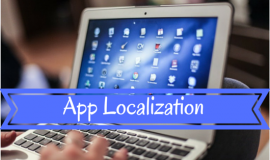
You’ve invested a lot of money and time in your software app. You want to see your app succeed and one of the ways to do that is monetization.
There are multiple app monetization methods to choose from and advertising often is often the obvious choice. Developers pay to include their ads in apps, such as freemium ads, banner ads, video ads, and more. Ads are expensive though. For example, in the mobile gaming industry, the average user acquisition cost for free-to-play games touched the $3 price point in 2015. When you multiply that out over thousands of users you’re talking about a lot of money.
App localization is a much less expensive way to get a big return on your investment (ROI) and attract non English-speaking users in existing and new markets. And it works. In this article, I explain what app localization entails, the wonders it can do for your brand and clients/users. I also give examples of problems that can be caused by localization done poorly.
What Is App Localization?
You start with translation, which is pretty clear and simple: the process of rendering a text from one language to another. Localization goes beyond translation. It’s the process of adapting your content (e.g. software and applications) and making it linguistically and culturally appropriate to target regions and languages. It means going from global to local.
Done properly, localization can provide your company and products innumerable benefits, such as increased revenues and decreased costs (all about ROI!), improved customer retention levels & increased market share. Successful software developers know that app localization is an important part of marketing in today’s global economy.
Localization Leads to More Downloads
One of the market advantages of localizing your software is a big increase in the number of downloads. A study of over 200 apps by Distimo found that downloads increased by 128% for the week after the app was translated into a country’s native language. That type of result would make any advertising company jealous.
Localization also worked well for Iris Shoor, co-founder of multiple startups. Writing on The Next Web, Iris explains how she used localization to triple her company’s product user base. These are not isolated instances. Study after study and story after story show that app localization is hyper-effective in increasing the ROI for apps and software.
Consumers Want Information in Their Own Languages
Many people are multilingual and most of your users probably know English, right? Not really. According to Sheffield Hallam University, only 6% of the global population are native English speakers and 75% speak no English at all. They still prefer to read and interact with apps, software and websites in their native languages. A 2011 study from the European Commission showed that:
- Nine out of 10 Internet users, when given a choice of languages, always visit a website in their own language.
- Nearly one in five Europeans (19%) said they never browse in a language other than their own.
- 42% said they never purchase products and services in other languages.
A different study from the analytics firm, Common Sense Advisory, with the catchy title Can’t Read, Won’t Buy: Why Language Matters on Global Websites, revealed more interesting findings. 75% of global consumers prefer to buy products in their native language and 60% rarely or never buy from English-only websites.
The Severity of Localization Gone Bad
Localization done right by professionals boosts global brand recognition and drives international business growth. Localization done poorly can hurt your brand and drive users away. 80% of international businesses suffer because of errors in document and web translation. Translation errors can hurt your brand. Translation errors occur because words have more than one meaning, even within the same language. The same word can mean one thing in one culture and something totally different in another. Just how embarrassing can translation errors get?
In his Inc. article titled 20 Epic Fails in Global Branding, Geoffrey James lists 20 embarrassing translation goofs, including labeling laundry soap as “Barf Soap” in Farsi and using the German slang word for manure as a product name for a curling iron. And those are just few examples. We may laugh when we see a product translation error or a brand name that sounds funny in a different country, but the effects of such errors are far from funny for the brand. At best, they make the company look out-of-touch and foolish. At worst, they can cost thousands of dollars in lost revenues, rework and recalls. (In other fields, like medical translations, the consequences can be even more severe.)
It takes a professional translator and native speaker to translate and localize a text the right way. Automatic and crowdsourcing translation solutions don’t compensate for slang, idioms, and unique language usage. You need someone who is trained, specialized in the specific terminology required, and knowledgeable about the target culture so that your company can make the best out of all the great benefits localization has to offer.
Does your app need to be localized?
For iOS apps, check out Apple’s Internationalization and Localization Guide. (By the way, did you know that the App Store is available in 150 different countries?!) For Android apps, refer to the Localization Checklist for Android Developers. Localization is not the only monetization method for your app, but it’s certainly one of the most cost-effective, easiest and fastest methods. It helps you and your app reach a global customer base and introduces your brand to new markets and users.
Image credit: SplitShire, edited with Canva
Author bio
 Professional writer and blogger Laura Spencer loves words, no matter what language they happen to be in. She writes on behalf of Lingua Greca Translations, a Toronto-based company offering Greek translation services, with a focus on software and app localization, to a wide variety of local and international companies.
Professional writer and blogger Laura Spencer loves words, no matter what language they happen to be in. She writes on behalf of Lingua Greca Translations, a Toronto-based company offering Greek translation services, with a focus on software and app localization, to a wide variety of local and international companies.







